Buck and I were out to dinner the other night with friends. The rather spirited and hotly debated topic of discussion-collecting. From the dictionary, a collection is a group of objects to be seen, studied, or kept together. That group could be as little as 2; anyone who owns more than one sports car, garbage disposal or vintage fountain pen is a collector in my book. Could one not get by with just one of each of these things? If you own one or none of something, you aren’t collecting, you’re just living. Some collections are entirely utilitarian. Dress shirts and sports coats, juice glasses, socks, garden books and steak knives-these objects in numbers serve a purpose. A clothes closet, a cutlery drawer, a bookshelf-these are means by which a collection is kept together for ease of use. Seeds harvested by a grower ia a collection that will be studied; the tomato seeds will be kept with other tomato seeds-maybe they will be tested for viability. Once the seeds of a given variety are packaged for sale, they may be displayed in a garden center next to packages of other varieties of tomato seeds. This kind of collection gets studied by the individual gardener. The gardener that buys seed for twenty different types of tomatoes-that person we might call an afficianado, or connoisseur, chef de cuisine, farmer, or a gardener that particularly values fresh and homegrown food.
Buck is a collector. He has a collection of vintage accordions-maybe 38, maybe 52. Many of them he has taken apart, cleaned, and restored. I am not sure how many he has, as all but 2 are packed away, stored in their cases. This is a group of objects meant to be seen. What about displaying 4 of them in every room of the house? This does not sound good. They should be kept together-but how? Displaying a collection is an art in itself. He also collects vintage movie projectors, slide wire potentiometers and other antique instruments used to precisely measure voltage. Every square inch of the walls of his den are lined with them. A pair of movie projectors from the 1940’s taller than I, sit on the floor face to face, and occupy one entire wall. Though not the usual room decor, this loosely related series of machines all from a particular period make a very strong visual statement. My interests could not be further from this, but I like collections created by an individual, rather than by committee or consensus.
A few years ago, I got him going collecting vintage composition dolls, doll heads, and doll parts. I always bring a little something back to him if I am travelling-a trip shopping to the Roundtop Antique show in Texas would be no different. Booth after booth stocked with every imaginable collectible object were set up in giant fields. An elderly lady had a booth that was entirely devoted to vintage dolls. She had countless glass jars full of doll parts. Many of these dolls had seen what Buck would call 1000 miles of bad road-dragged through the dirt, left outdoors, an arm missing. One doll head-a composition head with bleached straw like hair, half of which was gone, and alarmingly blue and fixed glass eyes – this would be perfect for Buck. Compelling, and a little scary-he likes this. But I walked away, thinking I might find something better. Of course I didn’t-nor could I find my way back to her booth. I thought about that head on and off all the way home; all I could do was tell him about it. A month or so later, a box of doll heads arrived. Soon they were arriving every day. He did an installation of quite a few of his collection on a wall-they look great.
Our dinner companions-they are good friends, and avid plant collectors. He was interested to know what Buck had to say about displaying collections. He waded right in where I would be reluctant to tread. When I go out to dinner with friends, I act like a friend. But Buck doesn’t design gardens-his involvement is strictly on the looking end. His take- a collection gains visual strength when it is arranged, grouped in a way that makes visual sense. As he is not a horticulturist, he sees overall shapes, colors and arrangements, not rare cultivars, or unusual specimens. It is one thing to garden with such ability that all of your plants perform and thrive. It is another thing all together to make them read visually. I have few clients who garden with such a range of plants even close to theirs. Conifers of all kinds, rare shrubs and trees, wildflowers, perennials of every description, tropical plants, roses, bulbs, dahlias-you get the idea . Their passion is for plants. I have no problem spotting a small start of a rare jack in the pulpit, or an unusually variegated Japanese maple-but Buck can’t see that.
Making sense of a collection visually means that you enjoy it just as much from a distance as you do up close. Once my collection of peonies got to 25 cultivars, I knew I had to arrange them in some way. I could have spread them out, planting a few in each of many perennial areas. I instead chose to line them out in rows, like crops. From a distance, the green rows were orderly, and made a big statement. This arrangement made caring for them easier. When they were in bloom, the mass of flowers was beautiful. When I collect one type of plant in depth, I like to keep them together. I like hedges of peonies, better than individual bursts of peonies. In my little south side rose garden, I did not plant one climbing rose. I planted the entire wall with a collection of climbing roses. I planted a collection of roses of only 3 varieties, that I thought would make a pleasing mass and interesting color contrast.
When I collect plants that are related by some organizing characteristic-such as dwarf conifers, meadow perennials, rock garden plants, bog plants-a collection such as this is broad, rather than deep. I would tend to arrange these related plants together, such that the overall shape of the collection makes as big an impact as a mass of one plant. Naming gardens and spaces helps to make clear what goes in that broadly concieved garden, and what would be lost, or just doesn’t belong there. I like plant collections that are arranged such that I see what made the garden maker collect them to begin with. If you are unable to edit your collecting, I am sympathetic. I do not do a very good job of this either. But I have a very small garden-my limits are clearly defined. A large piece of property-I would be out of control. One of the reasons I enjoy gardening for a living is the access I have to garden and plant collections other than my own.

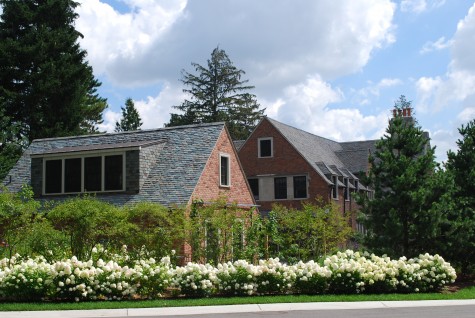

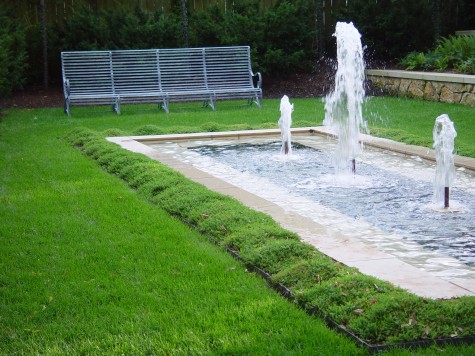


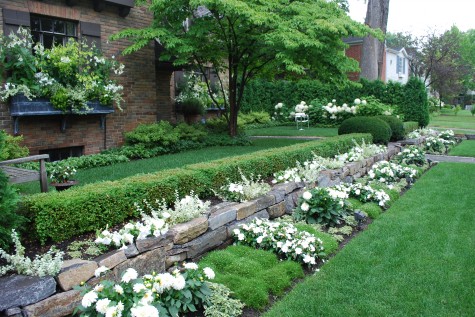
 A mass of red tulips in the spring is enough to get any gardener’s juices flowing again. That red is as densely saturated as a brand new lipstick. Lit from the front, these red tulips read vibrantly for another important reason-their companion color is green. The primary color red, and the secondary color green, are opposite each other on the color wheel. This opposition translates as maximum contrast. Red will never seem redder than when it is viewed next to green. Black/red and lime green-a great color combination.
A mass of red tulips in the spring is enough to get any gardener’s juices flowing again. That red is as densely saturated as a brand new lipstick. Lit from the front, these red tulips read vibrantly for another important reason-their companion color is green. The primary color red, and the secondary color green, are opposite each other on the color wheel. This opposition translates as maximum contrast. Red will never seem redder than when it is viewed next to green. Black/red and lime green-a great color combination.
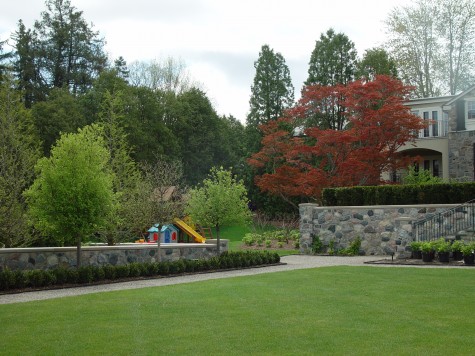 Not that muddy can’t be pleasing; the subdued red leaves of this very old Japanese maple make for an interesting variation in this landscape. The red is mixing and relating to other greens in the landscape in a subtle, not a jarring way. What is it about a dwarf red Japanese maple that makes it de rigueur in so many suburban landscapes? If it is the red color, then I see many plantings that do not present that red in a striking or thoughtful way.
Not that muddy can’t be pleasing; the subdued red leaves of this very old Japanese maple make for an interesting variation in this landscape. The red is mixing and relating to other greens in the landscape in a subtle, not a jarring way. What is it about a dwarf red Japanese maple that makes it de rigueur in so many suburban landscapes? If it is the red color, then I see many plantings that do not present that red in a striking or thoughtful way. 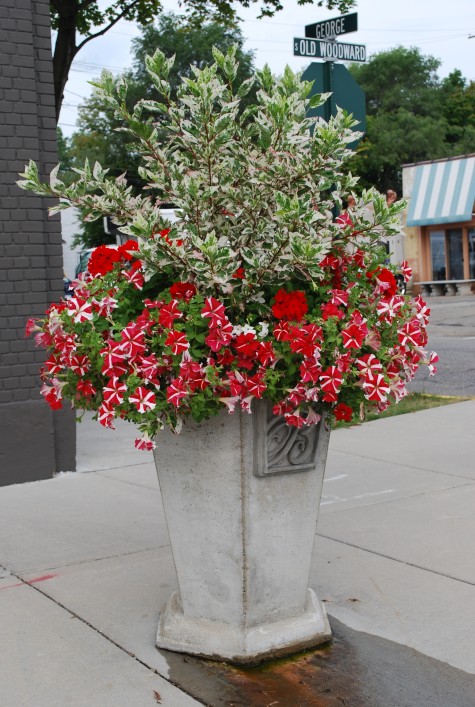 How red reads gets a big boost from white, or gray. Pale companionship or background helps red to hold its own. This green and white variegated hibiscus is grown primarily for its foliage. I used it as a centerpiece in this pot primarily to showcase the red. A thriving planting of petunias is much more about the flowers than the foliage-not much petunia foliage showing here. The white variegation on the hibiscus similarly reduces the amount of green. The red color is the star of the show. A red Japanese maple underplanted with Lamium “White Nancy”, or a dwarf low white variegated hosta might benefit in a likewise way.
How red reads gets a big boost from white, or gray. Pale companionship or background helps red to hold its own. This green and white variegated hibiscus is grown primarily for its foliage. I used it as a centerpiece in this pot primarily to showcase the red. A thriving planting of petunias is much more about the flowers than the foliage-not much petunia foliage showing here. The white variegation on the hibiscus similarly reduces the amount of green. The red color is the star of the show. A red Japanese maple underplanted with Lamium “White Nancy”, or a dwarf low white variegated hosta might benefit in a likewise way.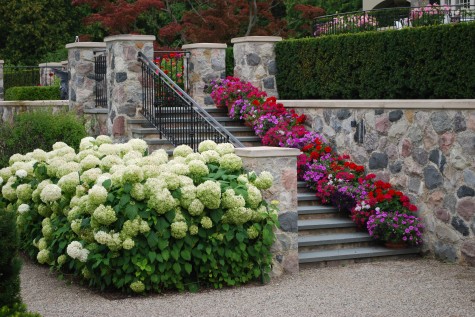 Mixing red with hot or magenta pink can add dimension, and sparkle, when the intent is to wow with red. The white of these Annabelle hydrangeas doesn’t hurt; the color all around seems lively.
Mixing red with hot or magenta pink can add dimension, and sparkle, when the intent is to wow with red. The white of these Annabelle hydrangeas doesn’t hurt; the color all around seems lively.  Intense or dark colors read best up close. To me, every composition has a foreground, a mid ground-and the background. These red geraniums are fiery, up close to the eye. The red dahlias in this mid ground-they seem much muted, even though they are the same red color as the geraniums. Lighting conditions and distance greatly influence the effect of color.
Intense or dark colors read best up close. To me, every composition has a foreground, a mid ground-and the background. These red geraniums are fiery, up close to the eye. The red dahlias in this mid ground-they seem much muted, even though they are the same red color as the geraniums. Lighting conditions and distance greatly influence the effect of color.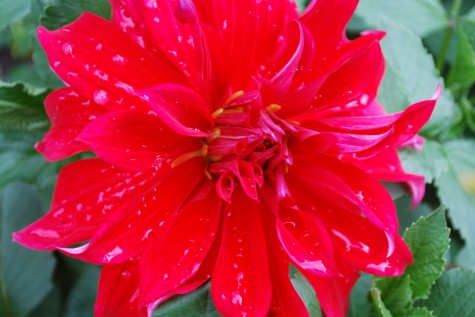 Dinner plate dahlias are something else-whether you love them or reach for your sunglasses, they are the most dramatic representation of red in the garden I can imagine. Were I interested in taking that red as red as I might manage, I would tuck them in between plants in a stand of arundo donax variegata. Red and white-so striking.
Dinner plate dahlias are something else-whether you love them or reach for your sunglasses, they are the most dramatic representation of red in the garden I can imagine. Were I interested in taking that red as red as I might manage, I would tuck them in between plants in a stand of arundo donax variegata. Red and white-so striking.  Some of my clients turn their noses up and roll their eyes should I use the word geranium. I look at them at the little black dress of the annual world; they can be stunning, in an expected way-but nonetheless, stunning. What you pair with red geraniums makes all the difference in the world. Whether by way of contrast, or by way of intensifying that fiery color, the idea here is to be purposeful. Whatever effect is in your heart or mind’s eye, understanding how color works will help make your idea visual.
Some of my clients turn their noses up and roll their eyes should I use the word geranium. I look at them at the little black dress of the annual world; they can be stunning, in an expected way-but nonetheless, stunning. What you pair with red geraniums makes all the difference in the world. Whether by way of contrast, or by way of intensifying that fiery color, the idea here is to be purposeful. Whatever effect is in your heart or mind’s eye, understanding how color works will help make your idea visual. 